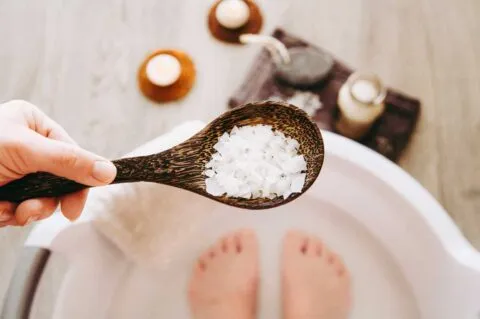
How to Use a Neti Pot for Sinus Congestion and Allergies
- Yield: 4 1x
Instructions
Ceramic Neti Pot:
- Fill your clean, dry neti pot with warm water. It should be warm enough to dissolve the salt but not hot enough to burn you. Add salt to the water and let it dissolve. We use about 1/2 teaspoon per 8 ounces of water. Too much salt and the solution may sting as it passes through your sinuses and too little minimizes its effectiveness. Swirl the water to help the salt dissolve.
- Next, lean over the sink (or do this in the shower!) and tilt your head slightly to one side. Place the spout of the neti pot snugly against the opening of the upward-facing nostril. Keeping your mouth open, tip the pot so the solution flows freely through your sinus cavity and out the other nostril. Some of the solution may drain from your mouth. You may have to adjust the angle of your head so that the solution doesn’t run down your throat.
- Pour through one nostril. Refill the neti pot and switch to the other side. You may notice one nostril seems more backed up than the other. Repeat if necessary (depending on the severity of your congestion). If we have severe congestion, we typically do this 2x per side OR 2x per day.
- Blow your nose afterward and keep a tissue close by… sometimes you’ll have a trickle or two shortly after. Always clean your neti pot after use (we often run it through the dishwasher) and allow it to air dry.
Plastic Squeeze Bottle:
- Fill your clean, dry bottle with warm water. It should be warm enough to dissolve the salt but not hot enough to burn you. Add salt to the water and let it dissolve. We use about 1/2 teaspoon per 8 ounces of water. Too much salt and the solution may sting as it passes through your sinuses and too little minimizes its effectiveness.
- Tighten the cap/spout on the bottle securely. Place one finger over the hole/ tip of the cap and shake the bottle gently to help dissolve the mixture.
- Next, lean over the sink (or do this in the shower!) and tilt your head slightly to one side. Place the cap snugly against the opening of the upward-facing nostril. Keeping your mouth open, gently squeeze the bottle to push the water through your sinus cavity and out the other nostril. Some of the solution may drain from your mouth. You may have to adjust the angle of your head so that the solution doesn’t run down your throat.
- Pour through one nostril. Refill the bottle and switch to the other side. You may notice one nostril seems more backed up than the other. Repeat if necessary (depending on the severity of your congestion). If we have severe congestion, we typically do this 2x per side OR 2x per day.
- Blow your nose afterward and keep a tissue close by… sometimes you’ll have a trickle or two shortly after. Always clean your neti pot after use (we often run it through the dishwasher) and allow it to air dry.
Notes
As always, this is not personal medical advice. We recommend you consult with your physician before moving forward with any medical regimine to be sure the treatment is safe for you.
Resources:
Rabago, D., & Zgierska, A. (2009, November 15). Saline nasal irrigation for upper respiratory conditions. American family physician. https://www.ncbi.nlm.nih.gov/pmc/articles/PMC2778074/.
U.S. Food and Drug Administration. (2017, January 24). Is rinsing your sinuses with neti pots safe?
https://www.fda.gov/consumers/consumer-updates/rinsing-your-sinuses-neti-pots-safe.
- Category: Do It Yourself, How To's, Natural Remedies, Health & Wellness, Recipes

























0 Comments